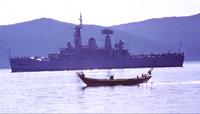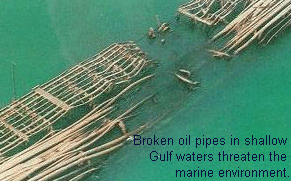

Nationalization of Oil in Iran
And
the "Creation of Arabian Gulf"
Siamak D. Ahi, May 26, 2005
The Invention of Arabian Gulf
The Idea of changing the name of Persian Gulf for the first time was suggested by Sir Charles Bellgrave the British diplomatic envoy in Bahrain in early 1930s. This suggestion was rejected by the ministry of colonies and foreign affair.
British Petroleum and Arabian Gulf
The first serious attempt to change the name of Persian Gulf was a British Petroleum policy. The motivation behind this effort was the revenge from Iranian people and government, because of the successful movement of nationalization of oil industry.
The first documented use of the fabricated term Arabian Gulf was in a book called The Golden Bubble of Arabian Gulf in 1952. The writer Roderick Owen was an agent of colonial apparatus in Emirate. He had close relation with the British secret service M16. He was also a policy maker behind British oil industry.
In short, the fabrication of the term Arabian Gulf and nationalization of oil industry in Iran happened at the same time.
Naser and Arab Nationalism
When Naser came to power in Egypt, the anti-Iranian propaganda and conspiracies increased significantly. This era was the beginning of the most dangerous and long-lived orchestrated effort to change the historical-legal name of Persian Gulf.
Naser put lots of pressure on the semi-independent countries of Persian Gulf. He used the financial resources of sheikdoms to promote the fabricated term of Arabian Gulf internationally. The efforts of Naserist regime and other nationalist Arabs particularly the Baathists in Syria and Iraq was very fruitful in cultural circles.
During 1960s and 70s numerous institutions were created to implement the propaganda plans of Arab nationalists. One of the main program of these institutions, which often operated in universities and research centers, was holding conferences and events.
They invited the scientists from all over the world and focused on some Persian Gulf issues. Under pressure of these events, the scientists used the term Arabian Gulf in their work and publications. The new so-called research institutes financed western scientists and researchers.
BBC and Arabian Gulf
In 1970s the use of Arabian Gulf was so spread around the world that not only many universities and research centers, but also private companies in business (particularly companies in publishing political-geographical business) and even governmental institutions were using the new fabricated name.
The most important achievement of these conspiracies was their influence on BBC. BBC was the most influential news agency in the world at the time. Foreign pressure and also the "Arabist" tendencies of senior officials of BBC led to their resistance in using the Persian Gulf. They welcomed the use of term "Gulf" instead.
This decision making of BBC in early 1970s had a very strong influence on the British publishing society. In mid-1970s most of British publications were using the term "Gulf" and erased the "Identity of Persian Gulf."
Persian Gulf Task Force
All these orchestrated activities of racist Arabs, which was often supported by their governments, remained unanswered. Unfortunately, there was no movement from Iranian government to oppose the conspiracies and saving the Persian Gulf historical identity. Even the independent and private Iranian research centers and businesses were silent and inactive.
The only hope for action was coming from the responsible Iranian individuals, who expressed their protests to institutes and companies, mostly in form of letters and meetings.
In 1998, with the creation of Persian Gulf Task Force, for the first time the defenders of Persian Gulf historical-legal identity, could act organized and coordinated. http://www.persiangulfonline.org/
Documents of United Nation on Persian Gulf
The United Nations with it s 22 Arab members countries has on two occasions officially declared the unalterable name of the sea between Iran and the Arabian Peninsula as the Persian Gulf. The first announcement was made through the document UNAD, 311/Geneva on March 5, 1971 and the second was UNLA 45.8.2(C) on August 10, 1984. Moreover, the annual U.N. conference for coordination on the geographical names has emphatically repeated the name "Persian Gulf" each year.
On History of Persian Gulf
The Latin term "Sinus Persicus" is equivalent to "Presicher Golf" in German, "Persico qof" in Italian and "Persidskizalir" in Russian, all of which means "Pars."
Prior to the stationing of the Aryan Iranians on Iran's Plateau, the Assyrians named the sea in their oldest transcriptions as the "bitter sea" and this is the oldest name that was used for the Persian Gulf.
An inscription of Darius found in the Suez Canal used a phrase with a mention of river Pars, which points to the same Persian Gulf.
Arabian Gulf in History
The Greek historian Herodotus in his book has repeatedly referred to the Red Sea as the "Arab Gulf."
Straben, the Greek historian of the second half of the first century BC and the first half of the first century AD Wrote: Arabs are living between the Arabian Gulf and the Persian Gulf.
Ptolemy, another renowned Greek geographer of the 2nd century has referred to the Red Sea as the "Arabicus Sinus." i.e. the Arabian Gulf.
Recognition of Persian Gulf
Persian Gulf, has been recognized as the real and rightful nomenclature not only by all ancient and past writers and historical nations but also by all modern international organizations and Int. societies among them the followings:
1- United Nation.
2- UNCSGN-United Nation Conference on Standardization of Geographical Names.
3- UN Cartographic Unit Staff.
4- IHO-International Hydrographic Organization.
5- IMO- International Maritime Organization.
6- IAPO-International Associations of Physical Oceanography.
7- IHB- International Hydrographic Bureau.
8- United nation Documents on geographical names.
9- UNICODE-Encoding Standards Consortium.
10- ISO-International Standardization Organization.
11- IHA- International Hydrographic Association.
12- UNGEGN-United Nations Group on Geographic Names.
13- UNGIWG- United Nation's Geographic Information Working group.
14- UNGIS- UN Geographical Information.
15- IAPO- International Association of Physical Oceanography
16- UNEP- United Nation Environmental Program.
17- UNESCO.
18- HABITAT.
19- WB- World Bank.
20- ICA- International Cartography Association.
Main Sources:
1. Persian Gulf and the conspiracy for changing its name,
Keyhan- London (in Pesian), Mahan Abedin
2. Conspiracy to change a heritage name "The Persian
Gulf", M.Ajam
3. A brief history of the name Persian Gulf, Atefeh Maziar.
4. persian gulf, from ancient time, has been Persian
Gulf, Dr. Mojtahed-zadeh
The articles could be found also here:
Pictures:
Top: Tehran, Baharestan square,1952
Right: Dr. Mossadegh



 High Traffic of vessels for oil transport, made Persian Gulf the Most Polluted Body of Water.
High Traffic of vessels for oil transport, made Persian Gulf the Most Polluted Body of Water. The basin is what we should know all about. We should know about all the rivers that run to Persian Gulf, About the ports and cities that dump their waste in it,… about birds, fishes,… and all form of wild life in and around it. A search that never ends, … as long as Persian Gulf exist.
The basin is what we should know all about. We should know about all the rivers that run to Persian Gulf, About the ports and cities that dump their waste in it,… about birds, fishes,… and all form of wild life in and around it. A search that never ends, … as long as Persian Gulf exist.  Iraqi marshlands are located in the heart of waters flowing to Persian Gulf. The waters of vast basin of Mesopotamia (see the map), is carried by rivers of Tigris and Euphrates to Persian Gulf. Therefore, whatever pollution in this vast basin, mainly in Iraq, will add to the Persian Gulf pollution. But before reaching persian Gulf, it will affect the life of marshlands, its people and natural resources. The pollution carried by Tigris and Euphrates can involve also Turkey and Syria which don't have any direct connection or access to Persian Gulf.
Iraqi marshlands are located in the heart of waters flowing to Persian Gulf. The waters of vast basin of Mesopotamia (see the map), is carried by rivers of Tigris and Euphrates to Persian Gulf. Therefore, whatever pollution in this vast basin, mainly in Iraq, will add to the Persian Gulf pollution. But before reaching persian Gulf, it will affect the life of marshlands, its people and natural resources. The pollution carried by Tigris and Euphrates can involve also Turkey and Syria which don't have any direct connection or access to Persian Gulf.













